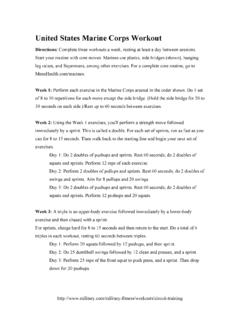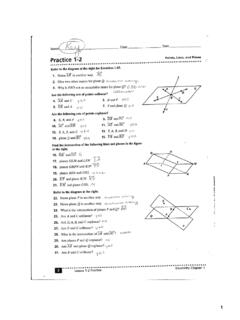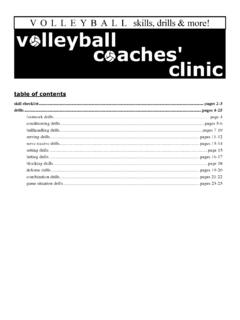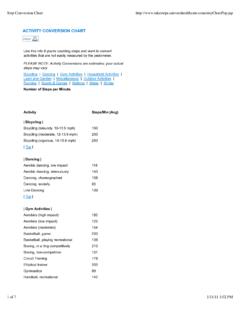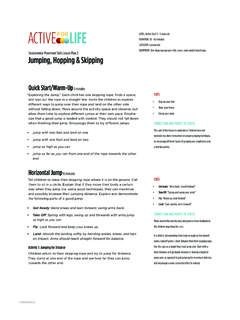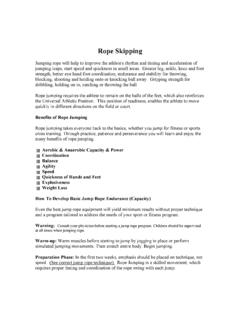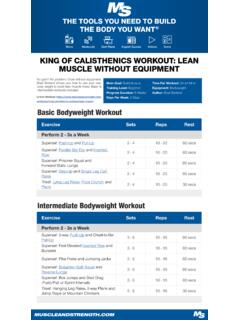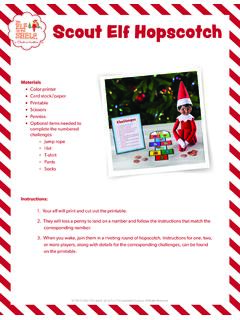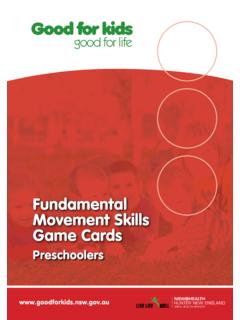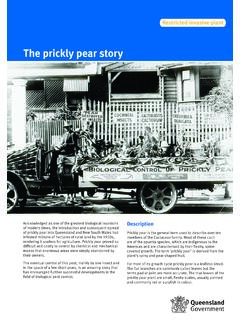Transcription of VOLLEYBALL skills, drills & more!
1 VOLLEYBALL skills, drills & more! table of contents skill 2-3 4-25 footwork 4 conditioning 5-6 ballhandling 7-10 serving 11-12 serve receive 13-14 setting 15 hitting 16-17 blocking 18 defense 19-20 combination 21-22 game situation 23-25 OHSVCA COACHES skills, drills & more! Presented by: Tina Jasinowski, Alter Girls' & Boys' Varsity VOLLEYBALL Coach Page 2 fundamental skills checklist serving lift - palm flat and facing up, "lift" the ball not higher than a ball width (or two) above head step small, natural step with opposite foot (right-handers: step with left) taken at same time as ball is "lifted" hand contact on ball - contact with palm, hand stiff arm motion - swift, contact ball above head with hand slightly in front of tossing shoulder - like throwing a ball weight transfer - transfer weight from back foot to front foot, through the ball as you make contact follow through - should be high , then arm will naturally come back down cues - "present, step/toss, serve" forearm passing thumbs aligned - positioned side-by-side hand-clasp - whatever feels natural, so long as thumbs are aligned (hand wrapped around fist, hand layed into other hand, fingers entwined, etc.)
2 Where to contact ball (platform) - ball should be contacted on forearms, above the wrists and below the elbows foot position (base) - feet at least shoulder width or a bit wider. bend at knees, not at waist to keep body and platform beneath the ball shuffle to ball - in moving to where the ball is, shuffle your feet, keeping knees bent and hips/head in a straight, vertical line (not a line that bobs up and down) step to target - once in position , step with whatever foot feels most comfortable (best to step from the right side of the court with right foot and from the left side with left foot), step in direction of target arm motion - arms should not move higher than shoulders, do not swing arms. use very little arm motion - DIRECT the ball to your target general body position - relaxed shoulders, knees bent, stay down and do not stand up as you pass relax - this is not a fast skill, should be done in a relaxed, controlled fashion.
3 Don t stab at ball, kind of shovel it to target overhand passing hand position - fingers spread and firm, hands in front of face. where to make contact - contact with ball should be made in front of face foot position - feet and body must be behind the ball, feet (base) should be comfortable and solid. making contact - hands & fingers should remain firm and strong on contact, NOT soft like when you set a hitter. follow through - as contact is made, push the ball to your target by extending your arms out from your face. be aggressive - this is an aggressive skill, you have to go to the ball with strong hands and push the ball away from you - you will not be successful with this if you just allow the ball to come to you and you play it passively . setting hand position on ball - form a triangle on ball with thumbs and index fingers, then spread apart so that hands wrap around sides of ball where to contact ball - hands should be up at forehead when contacting ball (if player takes hands away, ball should hit her in the forehead).
4 ALWAYS set from near the forehead, if the pass is low then get forehead low and set from there rather than just dropping hands and setting from chest or midsection shoulders square with target shoulders/hip s should always face the left-front target (front or backsets) foot position - you should set off of your right foot and follow thru onto your left foot net position (for setters) - sprint to the setting zone on the net (the position between the middle front and right front hitters), get as close to the net as you can without touching it and as you reach this position , "hop" so that you are facing the players on your own court to see the pass coming in body extension/follow through - extend out from feet all the way through hands (like a coil) when setting , you should hold your hands/arms out extended for just a brief moment after completing your like "superman" flying thru the air!
5 OHSVCA COACHES skills, drills & more! Presented by: Tina Jasinowski, Alter Girls' & Boys' Varsity VOLLEYBALL Coach Page 3 fundamental skills checklist (continued) hitting flamingo - these are the last two steps of your approach to hit and they should always be the same: a step-close, almost like a hop (very fast) - these steps should also "open" your hips up to the setter (as you actually hit the ball, you will "close" your hips to the net or your opponent's court) heel/toe step & jump - flamingo steps should be heel to toe so that momentum is transferred upward 3 or 4-step approach - most hitters add a third (and sometimes fourth) step prior to finish ing with their "flamingo" steps. these initial steps are generally larger steps designed to get the hitter TO where the ball is along the net explosive - hitting is an explosive skill, not relaxed like passin g arm swing - both arms should come back pretty far on the back swing and then both go upward to the ball, cocking your hitting hand up and back, alongside but above your ear, keeping your elbow high contact ball - reach high, contact the ball out in front of hitting shoulder (hitter should be able to see hand on ball, or she is probably too far in front of the ball) hand on ball - open hand, fingers spread and make hand stiff ( like a board )
6 Contacting first with palm wrist snap - snap wrist after initial hand contact on ball so that fingers come over the top to create topspin follow through - follow all the way through ball so hitting hand finishes down at same hip (right hand, right hip) floor defense and skills base the "base" position in defense is where players start out while the opponent begins their offense. in "base" players are simply protecting the court from "unexpected" occurrences (a errant pass coming over on the first hit, a setter's "dump", etc.) read - as soon as you know the other team is going to set the ball (not send it over on a first or second hit), transition from "base" to a read position and try to "read" what the opponent is going to do: who they are setting and what that hitter might be able to do with the ball (tip it, hit it down the line, hit it cross-court, etc.)
7 The higher the level of play, the more factors are taken into consideration in the read position defense - the final phase of playing defense is just that, playing the ball. when the hitter makes contact, STOP your movement and get low (even if you're not in the right place) - if you're still moving it will be harder to play it low position - once you get to your "read" position , touch the floor as the set goes to the hitter (or in drills as coach tosses ball up to hit) feet to the ball - take as many steps as necessary to get to the ball - run if you have to, but get TO the ball! play ball - this should be done BEFORE using any floor skill (don t use floor skill to play ball) use floor skill to recover - AFTER playing ball, use sprawl or barrel roll to get up from playing a low ball and guickly return to ready position to play next ball blocking hands - palms facing net, about shoulder height (middle-blockers: keep their hands a little higher, ready for a quick set); thumbs should be parallel to one another, pointing to the ceiling and fingers should be spread footwork - stay close to the net while moving position to position along net, use the "push , drive, slant" method to get from one position to another ("push" away from your starting position with your inside foot; "drive" (or run) one or two quick steps toward the hitter's location on the net.)
8 "slant" both of your feet like a "hockey stop" into the position you want to block from - make sure you are slanting both feet at the same time) jumping - when moving to block, or blocking from a stationary position , "load" your weight into a slight squat and jump from BOTH feet (especially when moving to the right/left) and jump straight up (not to the side, not into net) body position - blocker s hips/shoulders should be facing to the middle-back of the opponent s court arm movement - reach arms up and press from shoulders with a shrug-like motion hands on ball - hands should be almost as far apart as the width of the ball and they should be firm. outside blockers should turn their outside hand in towards the middle of the court (to prevent deflection of the ball out of bounds). shorter players can use a "soft block": instead of the palms of their hands facing the net, their palms should face upward (the ball will be deflected upward off their palms and can be played by a defensive teammate) follow through - when ball hits your hands, push it back across net (if possible, penetrate over net).
9 Do not bend your elbows back and forward to penetrate the net, just squeeze your hands over OHSVCA COACHES skills, drills & more! Presented by: Tina Jasinowski, Alter Girls' & Boys' Varsity VOLLEYBALL Coach Page 4 footwork drills (GREAT for WARM-UPS) Jump rope One of the BEST footwork . Have players do a combinatio n of regular, two-footed jumps; 1-footed jumps; "running" jumps (where they are actually running in place "thru" the jump rope - be careful that they are not skipping rope here, but actually running in place). You can also have them jump rope from one place to another (endline to net) or have them jump rope front and back or side to side over a line. Clocks Players create an imaginary clock on the floor and place themselves, facing 12 , in the center of the clock where the hour & second hands intersect. Using only the numbers: 12, 3, 6 and 9, players will move to and from those called locations on the clock with the transition footwork they would use in a game.
10 Each time the player reaches the 12, 3, 6 or 9 spot she goes into a ready position and simulates passing the ball, then does her footwork back to the center of the clock and repeats playing the ball. For variety , add other activities to certain numbers (rather than just passing). We use the following: 1) after moving back to the 6 position and playing the ball, the player does an approach jump to return to the center of the clock , 2) when moving out to the 3 position , the player does a blocking jump and then returns to the center to pass the ball (we also do the same to the 9 position), 3) when moving up to the 12 position , the player uses a defensive floor technique like a sprawl to reach 12, gets up and returns to the center to pass the ball. Line Jumps Players need to find a line on the floor. Have them do a sequence of 25 jumps side-to-side over the line on two feet, then 25 jumps side-to-side on their right, then 25 jumps side-to-side on their left.

